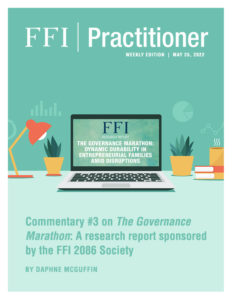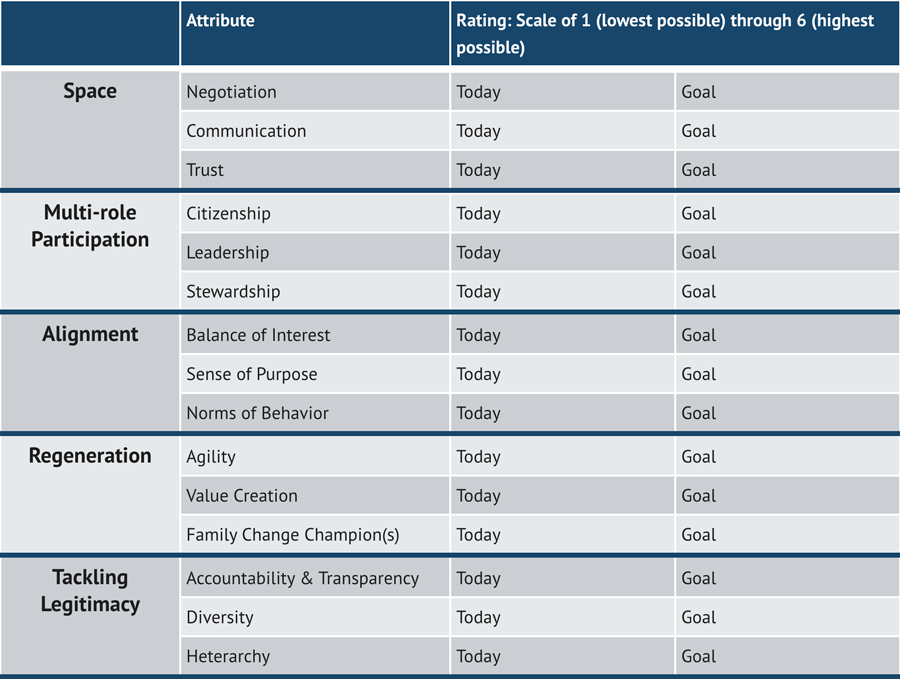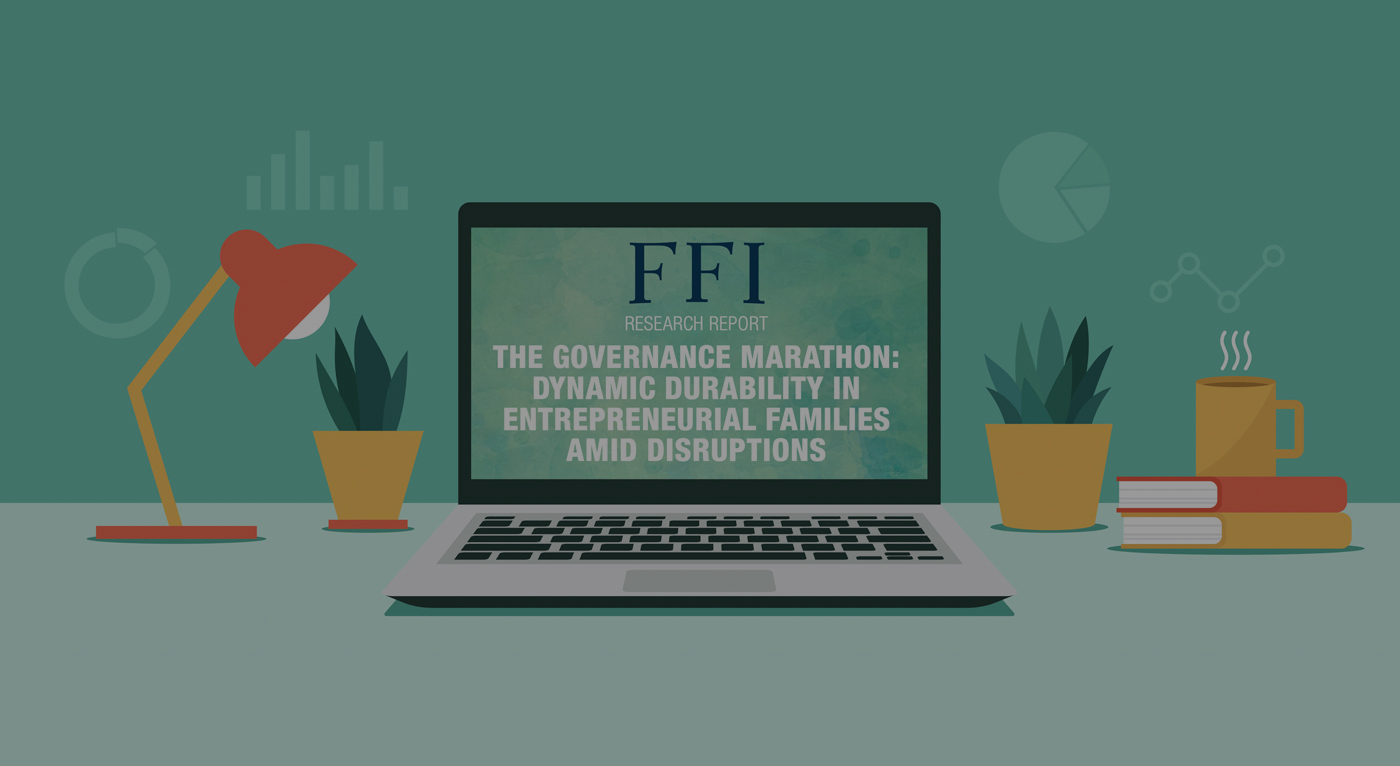
View this edition in our enhanced digital edition format with supporting visual insight and information.
This week we are pleased to continue our series of commentaries on The Governance Marathon: Dynamic Durability in Entrepreneurial Families Amid Disruptions, a report sponsored by the FFI 2086 Society. Thank you to Daphne McGuffin for her analysis and reflections on the report’s findings.
The Governance Marathon: Dynamic Durability in Entrepreneurial Families Amid Disruptions, a report sponsored by FFI’s 2086 Society, documents the findings of the research team’s assessment of how family enterprises can better manage the impact of disruption. The report provides new insights as to the role that “dynamic durability” in governance plays in successful and transitional family enterprises.
The commentary below emphasizes the practicalities of disruption and dynamic durability and how advisors to family enterprises might apply the report’s learnings in their practices.
Disruption Conjures Up an Image of Crisis and Disaster
The report references the caliber of disruptions that family enterprises are facing, including mounting geopolitical tensions, environmental degradation, demographic changes, ground-breaking technologies, and of course the COVID-19 pandemic. The pressure to pre-empt such disruptions is huge, and an effective, durable governance system is critical.
However, the dictionary definition also describes disruption as a disturbance or interruption. In essence, disruption is any change that impacts the existing family enterprise system. As we all know, change is constant, therefore disruption must be considered a permanent condition that needs to be proactively managed. Managing change necessitates managing the conflict that change inevitably creates.
Thinking of the family and ownership circles primarily, these are some common “disruptions” that might occur:
- Marriages and births adding new members to the family.
- Family members entering or leaving relationships.
- Next-generation family members or spouses becoming employees, shareholders, and/or directors.
- Senior family members aging and retiring.
- Death and disability changing the family and business structure.
- Shareholders exiting ownership to pursue a different path.
- A liquidity event that requires greater emphasis on wealth management.
- Diversification and investment in new ventures.
In family enterprises, these internal disruptions can cause just as much havoc. “Governance durability,” that is, having a governance system that anticipates the natural evolution of family enterprises, and the associated change and conflict, is a foundation of dynamic durability (p. 3).
How Family Enterprise Governance Might Evolve
Creating dynamic durability in family enterprise governance means finding a balance between what must remain constant and what must change. In other words, an effective governance system must be agile enough to weather change.
Mary Duke phrased it perfectly: “The durable and the dynamic must be in a balance. A governance system that can endure is flexible enough to accommodate the changes coming down the road, yet rigorous enough to have the effects we want in governance to carry forward legacy and values and continue a family’s trajectory. If it is too flexible, it falls apart. But if it is not flexible, it breaks apart. You have to find that even balance” (p. 9).
If the fundamental premise of dynamic durability is to “keep the governance system open, vibrant, organized, and adaptable” (p. 71), advisors need to help families anticipate the evolution of the family and the enterprise, and ensure they put mechanisms in place to regularly evaluate the current governance system so as to determine what might need to change in order for the system to remain effective. So, dynamic durability is finding a balance between structure and flexibility.

Dynamic Durability Cone (p. 19)
To guide family enterprise advisors, the report introduces the Dynamic Durability Cone, which illustrates which elements of governance are associated with durability and which elements are more dynamic and adaptable:
- Guiding principles at the top of the cone are considered the most durable as they typically relate to the fundamental question of why the family and the business exist. These are represented by the family enterprise vision, mission and values.
- Next are the structures that serve to uphold the guiding principles. Governance structures are constant yet need to grow and evolve over generations. There are two categories of structures:
- Anchoring structures, such as a board of directors and a family council, should be stable and robust.
- Supporting structures, such as advisory boards and committees, should remain adaptable and should serve as needed by the family enterprise system.
- Policies and Practices need to stay fluid to accommodate succession, align with shifting expectations, and cater to evolving contingencies.
An Assessment Tool for Families and Their Advisors
To evolve and remain effective, family enterprise governance must incorporate feedback and reflection. The report introduces the G-SMART model (p. 17), which offers advisors a framework for guiding family enterprises through a review of their current governance system and identification of any development necessary for attaining or maintaining dynamic durability.
The “G” stands for “governance” and the model depicts five “SMART” building blocks:
- Space: both a forum where stakeholders can exchange and collaborate and the psychological space where members are free to share their thoughts without fear of repercussion (p. 17)
- Multi-Role Participation: recognition that family members may play many roles and clarity around what authority, responsibility, and accountability comes with each role (p. 19)
- Alignment: equilibrium among stakeholders with a balance of collective interests and individual benefits as well as a flow between the elements of the Durability Cone (p. 20)
- Regeneration: the capability to build or refine principles, structures, policies, and practices within the governance system (p. 22)
- Tackling Legitimacy: managing transparency accountability and diversity in the governance system to ensure it is always relevant and appropriate (p. 23)
Within each building-block are three attributes that contribute to dynamic durability. The diagram below depicts a questionnaire that, from my interpretation of the narrative, advisors could use to help a client family self-assess where they are today in pursuit of dynamic durability, comparing that rating to where they ultimately wish to be. From there, they can consider what changes need to be made or whether existing governance measures and architecture should stay the same. Use of the questionnaire should be prefaced with some family learning about the function and value of each attribute.

Modified G-SMART Worksheet (p. 28)
Note that it is unlikely that any family enterprise has the capability to pursue all five building blocks (and their respective attributes) simultaneously. Priorities can be made based on current changes in their environment or on those areas deemed more relevant to their future.
References
Cheng, J., Au, K., Widz, M., & Jen, M. (2021). The Governance Marathon: Dynamic durability in entrepreneurial families amid disruptions. Research report commissioned by 2086 Society and the Family Firm Institute. Available at: https://digital.ffi.org/pdf/ffi_the_governance_marathon_report.pdf
About the Contributor

Daphne McGuffin, FFI Fellow, is the founder and principal of D3 Learning Solutions which offers a pathway of learning and support for family enterprises and family enterprise advisors on topics related to succession planning, successor development and family enterprise governance. Daphne is a faculty member within FFI’s Global Education Network (GEN) professional advisor development program. She has been a Kolbe Certified Consultant for many years and in 2019 was inducted into Kolbe’s Copper Circle. Daphne can be reached at daphne@d3learningsolutions.com.

View this edition in our enhanced digital edition format with supporting visual insight and information.





